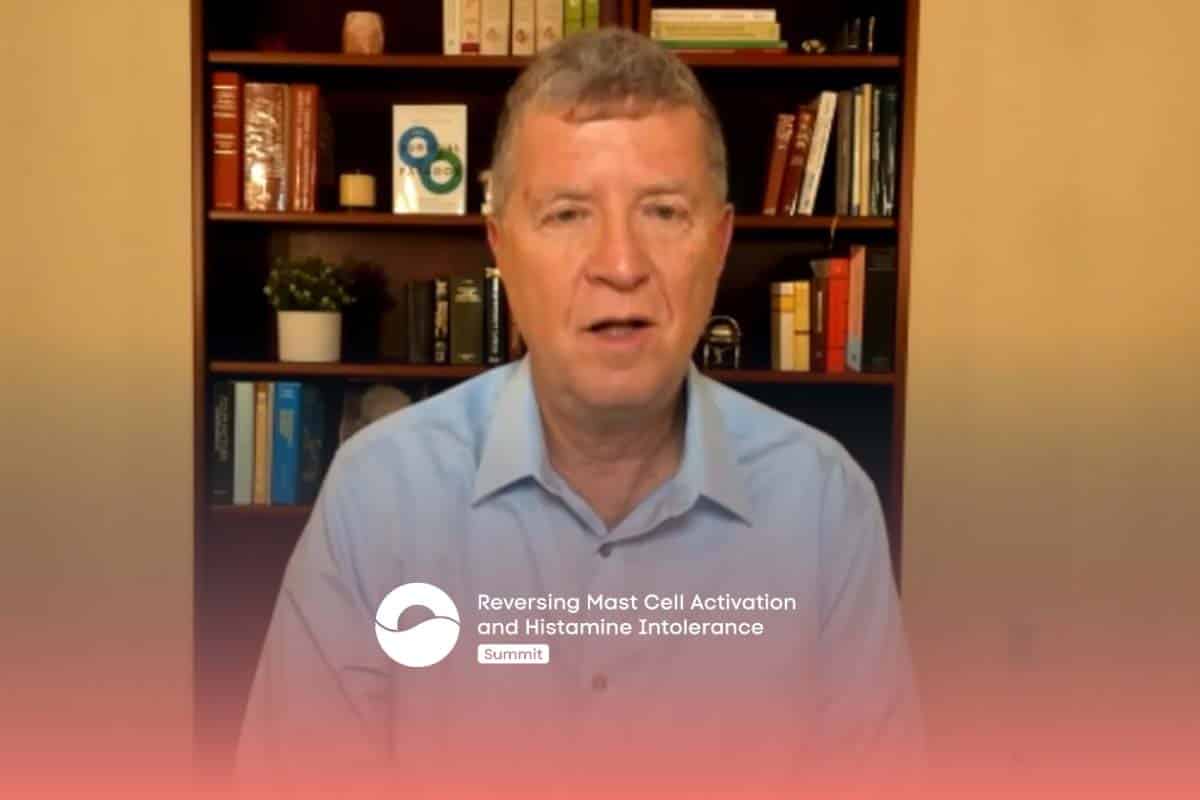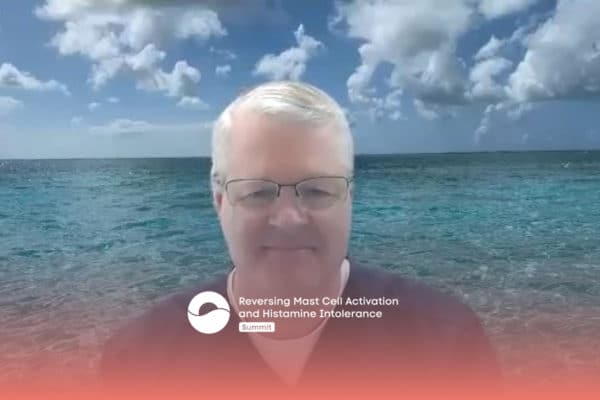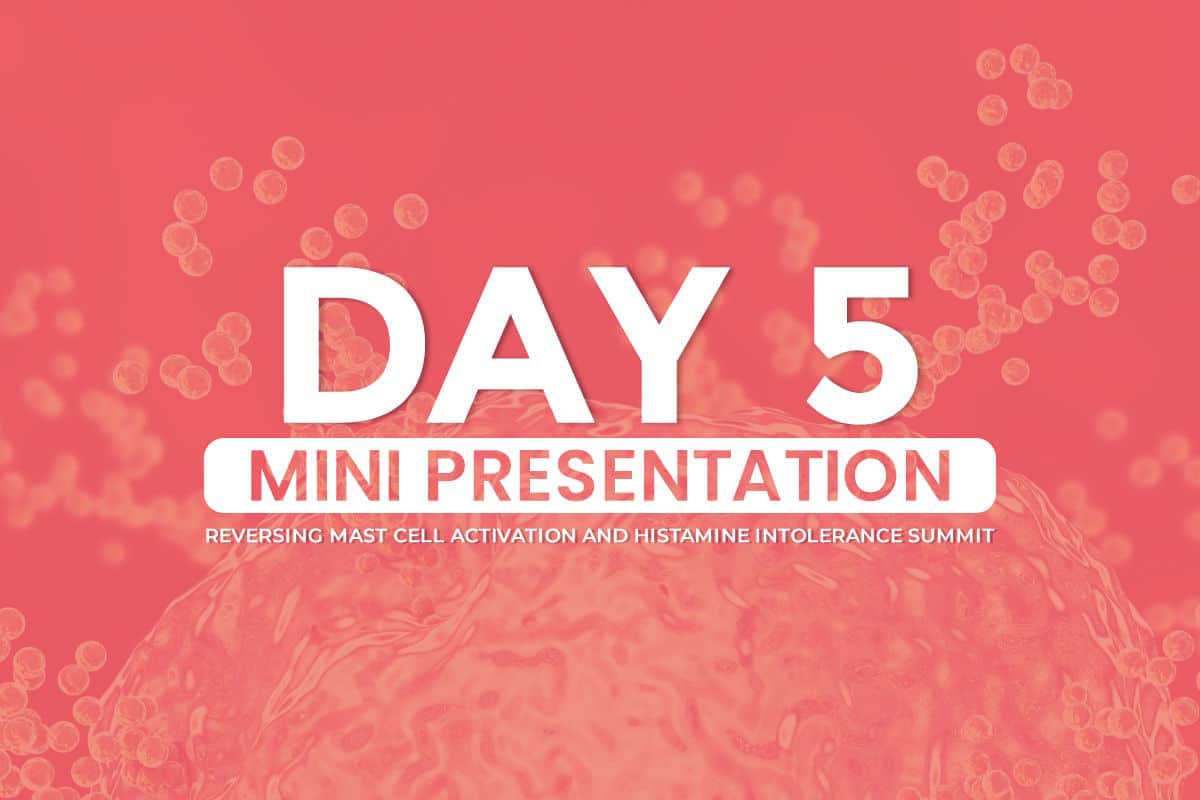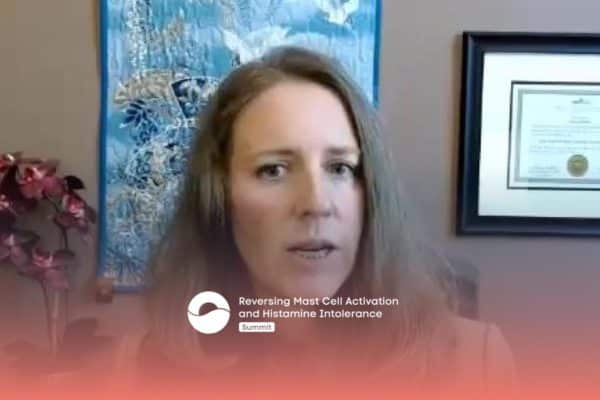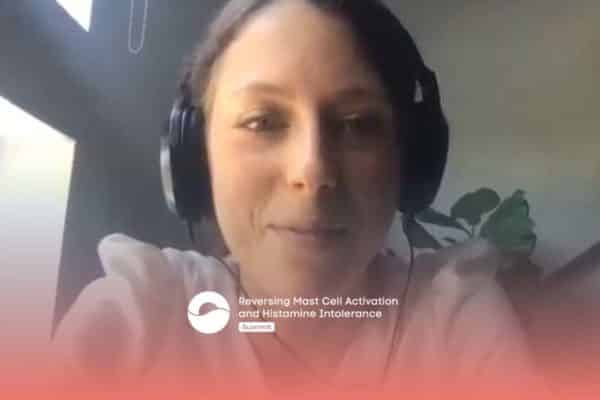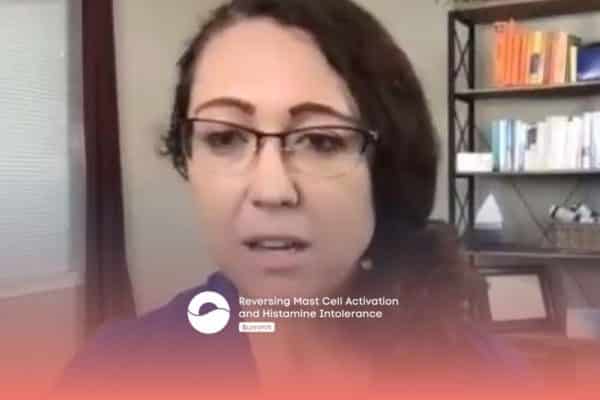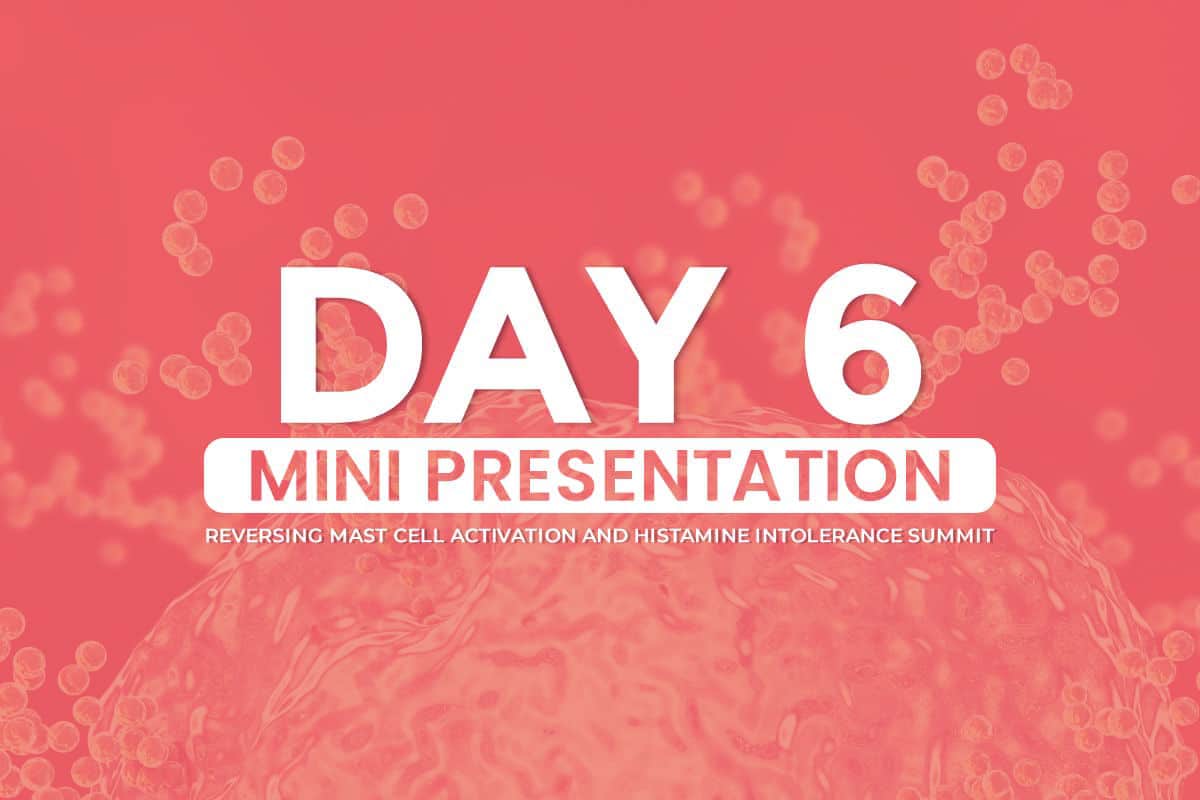Join the discussion below

Beth O’Hara is a Functional Naturopath, specializing in complex, chronic cases of Mast Cell Activation Syndrome, Histamine Intolerance, and Mold Toxicity. She is the founder and owner of Mast Cell 360, a Functional Naturopathy Practice designed to look at all factors surrounding health conditions – genetic, epigenetic, biochemical, physiological, environmental,... Read More
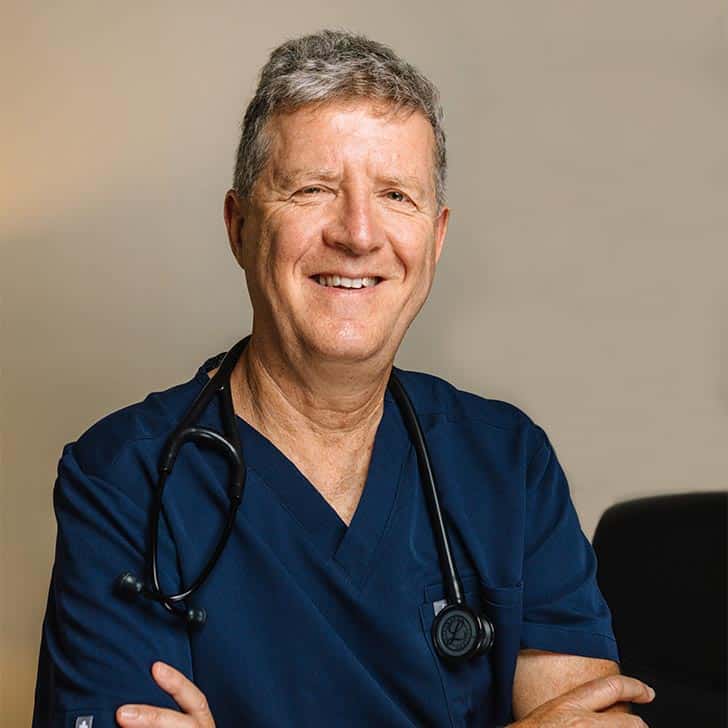
Isaac Eliaz, MD, MS, LAc has been a pioneer in the field of integrative medicine since the early 1980s, with a focus on cancer, immune health, detoxification and mind-body medicine. He is a respected formulator, clinician, researcher, author and educator, and a life-long student and practitioner of Buddhist meditation. With... Read More
- How mast cell activation can drive cancer
- Dr. Eliaz’s top cancer strategies
- Preventing cancer with lifelong strategies
Related Topics
Acidosis, Allergic Reaction, Angiogenesis, Arteriosclerotic Plaque, Atp Production, Autonomic Nervous System, Biochemical Relapse, Biofilm, Cancer, Cancer Development, Cancer Prevention, Cancer Risk, Detoxification, Emotional And Psychological Factors, Galectin-3, Gene Expression, Glycolysis, Heavy Metals, Hypoxia, Immune Response, Inflammation, Inflammatory Response, Mast Cell Activation, Metastasis, Modified Citrus Pectin, Proliferating Tumor Cell, Prostate Cancer Growth, Psa, Survival Paradox, ToxinsBeth O’Hara, FN
Welcome back to the Reversing Mast Cell Activation Syndrome and Histamine Intolerance Summit. I’m your host Beth O’Hara of Mast Cell 360 and I’m so delighted to have back with us, Dr. Isaac Eliaz. And today we are gonna be talking about the role of mast cells in cancer and ways that you can protect and take care of yourself and support your body in terms of reducing that kind of risk. So if you missed our first interview, I really wanna encourage you to go back and listen to that one as well. There’s some great context around the survival paradox. If you didn’t hear Dr. Eliaz’s bio, I wanna share that with you. Who’s an expert in the field of integrative medicine focusing on cancer, detoxification and complex conditions.
He’s a respected physician, researcher, best selling author, educator, and mind body practitioner, and he partners with leading research institutes including Harvard, National Institutes of Health, Columbia, and others to co-author, and he’s a co-author of many studies on integrative therapies for cancer, heavy metal toxicity and others. He’s the founder and medical director of Amitabha Medical Clinic in Santa Rosa, California, where he is pioneered the use of therapeutic apheresis treatment in chronic degenerative conditions. And he’s one of our biggest supporters on the summit, making it possible to get this information out to you. So once again, I just really wanna thank you for how much support you’ve given us and I don’t think we could have launched this without your help.
Isaac Eliaz, MD, MS, LAc
Yeah, thank you, and thank you for having me, you know, in this summit. It’s such an important summit and I’m glad to be part of it.
Beth O’Hara, FN
So now we’re gonna dive into the roles of mast cells with cancer. And this is something that’s always on top of my mind in terms of the levels of toxicity I’ve been exposed to, but not just me, but so many people we work with and then I know that mast cells can affect some of the immune pathways. Can you talk with us about the role of mast cell activation in cancer risk and the development of cancer and then metastasis?
Isaac Eliaz, MD, MS, LAc
Yes, so when we talk about mast cell activation and cancer, we can look at the phenomena of mast cell activation, and as you hinted, what is driving it? If we look at the survival paradox and just to briefly talk about it, the survival paradox, as it sound, is the paradox and it really offers a new paradigm shift in how we think about our health. So we are automatically wired to survive. We respond automatically within a fraction of a second through the autonomic nervous system that activates immediately upon threat, and that’s what happens. We get an activation, sympathetic system goes into fight or flight, increased heart rate, dilated airways, energy mobilization, inflammatory response that will drive mast cell activation symptoms but also will drive cancer to metastasize. And then the parasympathetic tries to rest and recover.
But we can see that over time, we don’t make it back to the baseline. Now, that’s a key thing. We don’t make it back to the baseline because of the traumatic event, because of the memory in the body that we talked last time and you shared your amazing story. Because of the PTSD, because of the memory that doesn’t allow us to respond fresh. And when we don’t respond fresh to the incidents without carrying a baggage of experiences from the past that relates to us or our ancestors, to epigenetics, to toxins, we no longer have a proprietary response where every time we just drop to our rest line and then we don’t have mast cell activation. There’s a normal response and it comes out but you can see, we really lose it. But then afterwards we get a biochemical response. And the biochemical response is driven by galectin-3 which is a carbohydrate binding protein that actually drives the inflammatory compounds into the different tissues. So I was gonna talk about cancer but just I want a little bit to explain about it before I go into cancer. So this is galectin-3. So what happen, this is a carbohydrate binding protein which means it binds to galacturonic acid, to different sugars. And it creates a lattice formation through pentamer.
It creates a coating, a biofilm and a arteriosclerotic plaque, a micro environment where toxins are hidden, where traumas are hidden from my perspective, from a holistic point of view, and the moment we have an initiation, or we worry about it, the area which is not functioning normally turns on and create inflammation or mast cell response. So this is for example, some of the compounds that are driven by galectin-3. So we can see the fibronectin collagen, the effect on the connective tissue, the shut down of the normal immune response, the growth factors, the effect on neuroinflammation, NG2 and GAGs and the sticky molecule that creates clogging and clumping and we don’t get oxygen into the tissue. And of course it drives multiple cancer pattern, VEGF. I mean, a lot of the ligands here are cancer driven. So galectin-3 bring them a time of crisis, but galectin-3 also activate the mast cell. So the same galectin-3 it will activate the cancer process and will create angiogenesis, will also activate the mast cell and create an allergic reaction and one will nourish the other. So if we want to look a very interesting slide is to see what happens when a cell goes under crisis. That’s really what happens in every cell that doesn’t feel safe, every cell that goes into glycolysis, every cell that goes into crisis. And really, mast cell activation is a sense of crisis that, you know, it’s over alertness, it’s over anticipation. So on one level, it can enhance an immune response.
And then certain people with allergies have less cancer with asthma, but then it will really drive inflammation. So this is a normal cell. When a cell feels safe, it normally uses glucose. Glycolysis is inactivated, P53, which is a big cancer regulating gene is activated. We get normal metabolism of glucose, MTO1 which will shut down, the mitochondrial function is not working and we get pyruvate coming into the cell and we get normal metabolism, very efficient. 36 molecules of ATP per glucose, but slow because we’re in a time of no crisis. When we go into crisis, and MCA is classical sense of always feeling in crisis, we shift to the abnormal metabolism which is identical to the proliferating tumor cell because the cancer cell is a cancer that doesn’t want to die, it want to survive. And it goes into this crisis mode where it divide and divide and divide and divide and produces and creates inflammation.
So in this sense, glucose is no longer used properly. P53 is shut down so the normal production of ATP through adenosine monophosphate kinase is shut down and then MTO1 get activated. We get a sense of hypoxia, like hypoxia on acellular level, and hypoxia like we don’t have enough air, and hypoxia like we feel in crisis, right? Many of the people with mast cell activation know it. You get a symptom and the mind goes into crisis. Oh my God, oh my God. And this contraction sympathetic biochemical is exactly what happens here. And then pyruvate get shut down and you go to glycolysis. Very fast metabolism, a 100 times faster, highly inefficient. Two ATPs for every glucose, a lot of lactic acid, a lot of acidosis, again, you shut down. Acidosis there’s no oxygen. Hypoxia inducing factor gets overly stimulated, PDK phosphate gets stimulated, PDH, pyruvate dehydrogenase, get blocked. Nothing comes into the mitochondria. So from a strategy, from a naturopathic or for molecular, you wanna make sure you have B1 and B12 and thymine and alpha lipoic acid, but you also want to make sure that you shift into a state that is not a survival state. And this is why it is really important because it will affect what will happen in cancer and it will affect what will happen in our life.
And in my book, “The Survival Paradox,” I have a story about a woman who just comes with a stage four lung cancer. She’s in a survival mode, she’s in a crisis and it’s affecting her cancer. And once she shifted it, it’s remarkable for how many years she lived. So in this way, mast cell activation is the disregulation of the immune response causes heavy price. And that’s why part of strategy for mast cell activation, a part of strategy for cancer is detoxification. The cell has a choice if it wants to function normally or it doesn’t wanna function normally. And there are so many reasons for this, right? We all know it, it’s like emotional, psychological, gene expression, toxins. Certain things we don’t have so much immediate choice. You know, if we have a certain gene exposure, but we have a choice from an epigenetic point of view, are we going to activate the gene or not? But if we have a high load of toxins and heavy metals and multiple system that are not functioning well, it will affect our ability to have a well functioning body, but also to prevent cancer and to prevent the inflammatory fire of cancer.
Because we know the more aggressive cancer, the more it consumes glucose, the more it goes into this diagram that I showed, the abnormal fast, right? This is what PET scan is about, right? They give glucose and cancer lights up because it’s consuming a lot of glucose. So that’s a very basic relationship. And whatever helps us to balance out mast cell activation will naturally help us in cancer prevention strategy with the key thing being, addressing the survival products. And that’s why addressing galectin-3 with modified citrus pectin is so fundamental to the strategy. Now we are just publishing a paper on biochemical relapse of prostate cancer. It’s very interesting because it relates to our subject. So the users of the modified citrus pectin and it develop in people whose prostate was taken out because of cancer and phosphate is just an example, but it’s very easy to follow up because the PSA is a very reliable marker. When you don’t have prostate, you have no PSA. PSA shows up, you know it’s cancer. So the prostate is taken out and then it starts coming back biochemically. Sometime you can see, sometime you don’t see it yet. It’s called biochemical relapse. That’s our third study, it’s a multicenter study.
And we published that after six months, about 80% of the patients, for 80% it either slowed down the cancer growth, stopped it, or the cancer went down. That’s remarkable but interesting. Some people who didn’t respond out of the 20% decided to continue, and they responded after one year and responded now for years. So it took them a longer time to change everything that we were just demonstrating. And then we took the people who got results from six months. So the study was 60 people, six ecological centers in Israel. So we took the people who got results for six months, it was, you know, close to 50 people. And some of them decided just to buy the product who didn’t want to really worry about the study. And then we followed them for another year and this we are publishing now so I can’t give the exact data. But compared to the baseline, 18 months earlier, 90% of the response, this is 18 months. You know, there are very few treatments in oncology that works for 18 months, right? And actually make you less inflamed. Why am I giving this an example? Because we regulated the survival response, the side effects were less, joint pain, better memory, et cetera, right? What we are looking when there is reduced inflammation. And as part of it, the modified citrus pectin doesn’t kill cancer. It allows the body to properly respond to the cancer without creating an inflammatory response. And this is really our goal with MCA.
To regulate, to take care of the problem without creating an inflammatory response. Because the inflammatory response, as we know, for example in the gut would create leaky gut and then the whole autoimmunity and gut brain, the connection and effects the neuroinflammation. And of course we can see connection with galectin-3 in the gut and then with aggressive bacteria using it to adhere to the lining. And we can see it in the brain in disrupting the blood-brain barrier, very similar and potentiating driving post ischemic inflammation in the brain tissue. So it’s fascinating that the very basic mechanisms are showing up in different places. They are just expressed in different ways in different molecules. It’s the macrophage in our circulation, it’s the microglia in the brain, and the Peyer’s patches in the small intestine. It’s different immune responses that have multifunctional world that we are now much more aware of.
Beth O’Hara, FN
This brings together so many pieces we’ve been talking about on the summit. And I just wanna recap for our lay people and brain fog people that we’re talking a lot on this summit about how we live in this toxic world, the epidemic of mold, there are piles of studies about how carcinogenic aflatoxins, ochratoxin, and zearalenone. And it’s a concern for, I think most people living on our planet because we don’t live in the pristine environment anymore. And so I love the slides that you showed. I was familiar with the MTO, the AMPK pathways. This is not my best area in biochemistry, but I knew at least from that, that pathway, that reducing sugar, reducing the exposure to the estrogenic compounds and dairy and plastics, reducing EMFs, all these things that drive those pathways, help reduce cancer risk. But you’re really taking us even more upstream to where galectin-3 has a trickle down effect. So if we can get even more upstream to that galectin-3 with things like modified citrus pectin, then we can really help shift that cellular metabolism out of this survival state, the survival paradox state, where we’re burning a lot of glucose and driving those cancer cells back into what I think of as an autophagy state, which might lead to-
Isaac Eliaz, MD, MS, LAc
Exactly, no, right. And that’s why intermittent fasting for example, is so important, you know. But if I’m gonna borrow this slide again and show this, so it’s interesting. So we really have to understand that galectin-3 is working outside the cell, in the connective tissue, in the extracellular and in the receptor, the insulin receptor that is disrupting because it’s activating the macrophage. I don’t have this slide here. And maybe I have in one of my other slide, but I don’t want to get people too confused. So think about outside the cells that this macrophage that are becoming inflamed because they’re getting a message of crisis from galectin-3, or they’re starting to excrete galectin-3, it disrupts the membrane and then you got everything going on. So one phenomenal compound, it is really unparalleled is a compound called Honokiol that’s really fascinating. And it relates, so people who take Honokiol often will feel, wow, my brain fog is gone, you know, my mental clarity.
And it’s very important for neuroinflammation. And really studies are amazing, but also in cancer. And it’s synergistic with practically, if you look at the literature, again, not a lot of human trials, unfortunately animal trial because there’s no money to be made from Honokiol, from pharma. I publish the only human data in cancer, actually with intravenous Honokiol which I don’t do anymore. So what Honokiol does, Honokiol can differentiate a normal cell from a cancer cell. The cancer cell, it’ll put oxidative stress on the cell and kill it and in the normal cell, it will make sure that it become an antioxidant. So in the cancer cell, it’ll block MTO1, it’ll block AMPK, it’ll block AKT, and it’ll activate PTN and P53. So totally normalizes the cell. Now, if you look at Honokiol’s data, it’s antimicrobial, antifungal, antiviral, almost every pathogenic organism. Why, because in times of infections, these cells also get dysregulated. So for example, we have now seen as part of my new recommendation, I recommend MCP with Honokiol for neuroinflammation and we’re getting insane, insane feedback. I’ve never expect it. But the reason is that we are addressing the abnormal survival driven upstream inflammation, and we are addressing the intracellular normalization of mitochondrial function. So berberine does some of this, but more specific here. And then curcumin does some of it. Honokiol is just unparalleled because also moves the brain from excitatory glutamate phase to a GABA phase. So people who take Honokiol feel very relaxed and focused.
So what happen, if we can feel more relaxed, we talked about it last time, the mast cell response goes down, you know, the anticipation, the excitatory tension just goes down. And in this sense, yeah, it’s really remarkable. Lectus is an example of a compound, of course, but the idea that we have to see where we are and how we can be creative about addressing it, right? So we talked about toxins and then how big is the role of the gut? And then how big is the role of neuroinflammation? And how big is the role of mitochondrial function? So when we put the different pieces, we can really make things work. And often, and microtoxins are huge. You know, I’m doing work on GlyphoDetox with Glypho that we’re getting great reduction, but we’re also seeing a milder reduction in ochratoxin in all the subjects. But we know, they all relate to each other. You know, we live in a world where we are affected by so many places. So these are very important strategies which are often overlooked in oncological treatments. And they’re actually essentially in oncological treatments. So when somebody has a big toxic load, especially microtoxins which tend to be fat soluble. So this is what therapeutic apheresis comes in. And what I can get in one treatment of therapeutic apheresis you can do as many AVs as you want, you’ll never get it.
Because what happens, we are filtering out all the oxidized lipids and the toxins that are bound to them. And for specifically in my approach are integrated with phosphatidylcholine. So I’m exchanging, you know, normal phosphatidylcholine with fat soluble, you know, a soluble toxin that are bound to the membrane and the machine just pulls it out. So it’s interesting because the same treatment will make immune response better to cancer. And I used to use a lot, I don’t use now, it’s hard how to get BCG vaccine, which is giving intradermal and it’s really effective and inexpensive, but people with metastatic disease cannot produce an immuno response. You just do a skin test PPD, you don’t see it. But when you do a forensics and you’re cleaning the blood and you do it immediately, suddenly you get an immune response.
Why, because all the inhibitors of the immune system that the cancer is excreting and all the toxin that are dysregulating our immune system are being removed. So this is a more radical approach when somebody really, when there are no choices left but in general, that’s what we’re trying to do in a milder way. And I think that the long haul COV!D and people who have side effects from vaccine are in the same category, doesn’t matter. What is the opinion on this activation of the immune, this regulation of the immune system is very much related to people who have MCA, people who have a high toxic burden. It doesn’t come out of the blue, you know. It’s remarkable to see some people with high microtoxin level and the neurological diseases they have. I see people in the 70s showing up with neurological diseases that are supposed to show up only when your 20s you know, after this incidents. So I think that the strategy has multifaceted benefits.
Beth O’Hara, FN
And so to pull some more pieces together for people, I wanted to share some things around the Honokiol ’cause that might be a new supplement for people to hear about. When I’m looking at cases, I’m always thinking what’s the pathogen load, what’s the toxin load, what’s the stressor load, whether we’re talking about emotional, mental, physical stressors. And some people have a, when I share my story, some people have a hard time believing that these things happen, but I had such terrible glutamate issues, Dr. Eliaz, that even having a couple peas would make me feel, and they have some glutamate, would make me feel like I had fireworks going off in my brain. And Honokiol was one of the things that quite helped me. And for people that haven’t heard of this, it’s Magnolia bark extract. But the key with it is it has to be a very high grade, very pure quality extract, and you can find ones that are the 25%. It’s not inexpensive, it’s costly to make. But before-
Isaac Eliaz, MD, MS, LAc
Very costly, yeah.
Beth O’Hara, FN
Before I knew who you were, I tried several and the only Honokiol that made the difference for me was the clinical synergy. And I noticed a big difference with the purity and I’m gonna link to that so people can find it on our summit Resources Page at mastcell360.com/summit.
Isaac Eliaz, MD, MS, LAc
And, you know, I overlooked this importance. Thank you, I was talking to my dear friend, Eric Gordon, he was sharing the same feedback because I’m so cancer focused and actually developed an intravenous treatment for this. And then, you know, you’re focused on one area but Eric was telling me, you know, it’s helping the microtoxin neuroinflammation. You know, Isaac, I’m seeing it, you know. And yes, it’s definitely, we actually published, I mean, our publication on Honokiol are mainly in the field of cancer, but also we’ve published the synergistic antioxidant benefits with modified citrus pectin, you know, we do research and other staff. So yes, it really supported. The beauty and the excitement for me and why I’m in a mission to share this now is that this synergistic effect we can create affect us in so many diseases, in so many conditions.
Beth O’Hara, FN
And with the, I just wanna come back to the Honokiol for just one moment. I found that people, we have so many sense of people in this population, but I found that when people tolerate CBD, they tolerate PEA, they’re gonna tolerate the Honokiol, that’s the pattern I’ve seen. And it’s really about bringing it in for sense of people at the right time, but I love that product. So we know that we’re all living this toxic soup now, and we got these EMFs, and we’ve got 5G and we haven’t gotten 5G on my street yet. And I’m hoping I’m close enough to the woods that I won’t get sapped, but this is a different world we were living in than a 100 years ago. In my mind, we need long-term lifelong detoxification strategies. We don’t wanna wait. And not everyone with mold toxicity develops cancer. I’ve been really lucky so far, I think, with my own toxin load, but I have had a good number of people came through and either they had cancer already, or they developed cancer before they were able to get these toxins out. Can we talk in the big picture in terms of this? I really want people to be thinking about not waiting till cancer happens and then having to treat it. And there’s a lot that can happen there, which is great, but also how do we take care of ourselves so that we don’t go down that road and we can stay off of that path?
Isaac Eliaz, MD, MS, LAc
Right, that’s a great question. And it can be more challenging for some than others because we get our genetic predisposition and, you know, which families with a deep family line of cancer, which is not always genetic. Sometimes they lived in a toxic area for multiple generations, right? You can see, and suddenly the people who moved early on are okay. I mean, I grew up in the street where we had huge, literally 50 yards from the house. We had huge of the high, high, you know, the electrical wires, the huge ones that are like 100 yards above the ground. You could hear them, you could feel them. Every single house in the neighborhood had cancer, weird cancers for the adults. At certain point they were removed, but definitely I got some of them in my childhood. So there are different levels. So one thing is we got to address galectin-3 on an ongoing basis. I can’t emphasize this enough and not because I developed this and I’ve done it for almost 30 years and I have a lot of the discoveries.
Because it truly addresses a fundamental pattern of destruction and aging and driving chronic inflammatory and fibrotic diseases and cancer. The other thing, as you said, we have to constantly address toxins. So one is eating well, drinking, good quality water. But the sad part is that we cannot control it. If there are airplanes flying above your house, you’re getting MTB products. If you live in a flat area and somebody’s spraying glyphosate 10 miles away, it’s gonna come into your water. So we have to have a daily regimen where we clean our pesticide and microtoxins. So pickle salt does some of this, does actually a lot of it, also has systemic effect. GlyphoDetox is a great addition and we are seeing the combination. But I think also taking good care of your microbiome ’cause the microbiome is really our synergistic symbiotic guard. It allow us to absorb nutrient.
It allows us, you know, it protects the integrity of the gut and also to look what creates toxicity in our life, in our mind, emotionally, psychologically, it’s all mixed together. And we have to realize that because the cell has a choice to go into a mitochondrial normal function or an abnormal glycolysis based crisis function, so do we as people. Every second, every breath, every thought. We have the choice to just let go. And when we let go, and specifically for MCA, it’s not only the anticipation psychologically lets go. The biochemical response lets go. The mast cell is not being activated. And it’s tricky, it takes time for people with very strong MCA tendencies. You can feel that you are changing your mind and changing your habits and the physical level, you know, from working with so many people will come sometimes right at the end. It’s like the last curtain that will be unveiled and suddenly is the room is full of light. For some people, it happens right away. We see it in meditation and healing retreats how it can happen so quickly.
Beth O’Hara, FN
So we’re talking about, we have to keep detoxifying all the time, it’s not something that we do just short term. And I really like doing some of these things and doing sauna. And we’re also talking about the role of our mind state, our stress states, our nervous system, our energy, keeping those layers clear. And I just wanna also realize for people who didn’t watch our first interview, that just to touch on that, if you’re using the modified citrus pectin, it has to be the very small size. So we’re gonna link to the kind that you’re talking about again, on the summit Resources page because there are a number of them out there, but they’re not the kind that was used in your research. So we’ll have that listed too for people.
Isaac Eliaz, MD, MS, LAc
And you know, one more word about detoxification because we detoxify all the time. Every time we exhale we detoxify, every time we inhale we nourish ourself. There’s a dialogue between detoxification which exhalation takes twice as long as inhalation and nourishment. But there’s also a more concerted effort of detoxification. And for people who are relatively healthy, the best times, if you can, are in the spring and in the fall. And detoxification really has stages that you really need to prepare. It’s a whole process. I write about it in my book, in the chapter of detoxification and make sure that I include this chapter. I mean, I have a diagram on it here, but I think we’ve talked long enough for this time. But really, when you detoxify, you wanna prepare. You wanna know, what do you wanna get rid of? You want to expose what needs to be exposed. You want to bind, you want to help the discharge through the liver and the elimination. And you got to give support. Nourishment, tonification, circulation, balancing. And these are all the steps of detoxification. And if you do them, you will have a smooth detoxification without crisis.
Beth O’Hara, FN
So before we wrap up, I also know that you had some tips for people around brain inflammation, around brain chemistry to help them be less reactive. And there’s that role in that brain inflammation and the type of sensitivities that we see. Can we just briefly touch on those?
Isaac Eliaz, MD, MS, LAc
Yes, so when the brain goes into, so putting the gut brain connection aside, when the brain goes into a crisis mode, into a survival mode through galectin-3, the blood-brain barrier is disrupted. Molecules, pesticide, microtoxins penetrating to the brain and they activate the immune cells of the brain, the microglia. The microglia can be affected by toxins but it’s directly affected by galectin-3. The Alzheimer plaque has 10 times the concentration of galectin-3 compared to normal tissue. But interesting when we have perfusion injury, when we don’t get blood to the brain for a fraction of a second, it doesn’t have to be a stroke and be just, you know, we locked our neck for a second. Our blood pressure spiked. We didn’t have enough blood supply. The tissue will respond with microglia driven inflammation. And that’s what damages the brain. And we have shown, studies have shown. studies published this year that it’s driven by galectin-3 and modified citrus pectin will reverse it. So when you take modified citrus pectin and Honokiol as a combination, you don’t need a lot of Honokiol for brain function. One capsule a day of Honokiol. If you want, you can do one twice a day, it’s usually enough.
But if you combine it with a full dose of modified citrus pectin, you will see a difference in your brain function. And in the same time you wanna support the circulation to the brain, essential. So any herbs, botanical, Nattokinase, Lumbrokinase, anything that helps you get better circulation to the brain, the health of your neck, that it’s opened can be, you know, if we have neck injuries that can be devastating. And so all of this will really affect because the brain is spoiled. It wants to get its supply all the time, you know? So in this sense, neuroinflammation is a treatable condition. And especially when it comes to memory and Alzheimer, it’s really treatable. It’s not something that cannot be treated because if we improve circulation, if we reduce oxidative stress, if we shift the body and we shift the brain cells from an inflammatory state to normal state, we will see a difference in our brain function.
Beth O’Hara, FN
Which is wonderful hope for people because I know from my own health experiences what it was like to go from being a star academic to not being able to read a book. And I got my brain back and I’m able to do this work now and read complicated research literature. And a lot of what you’re talking about is what helped me recover. Getting the toxin load down, the pathogens actually improved mostly on their own, and then this stress state and the neck. So I have a Chiari malformation and some issues here, and I get glymphatic drainage every two weeks. And I have my head of my bed raised up so I get good drainage. It’s made a world of difference. I just wanna thank you so much for the work that you do in the world for how much you put out there. We need practitioners to have the kind of dedication and passion and excitement to help us solve these kinds of complicated health mysteries with the world that we’re we’re living in. But I know that we’re doing it, I know that you’re doing it. And thank you from the bottom of my heart for everything that you do.
Isaac Eliaz, MD, MS, LAc
Thank you, thank you for the opportunity, for the amazing work that you’re doing. It’s an honor to be part of this summit.
Downloads

